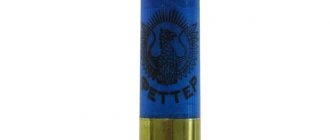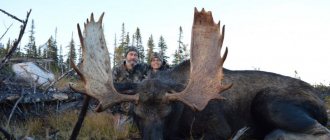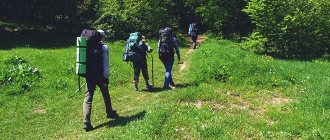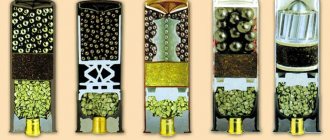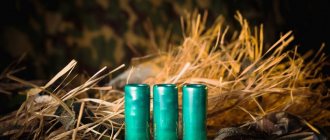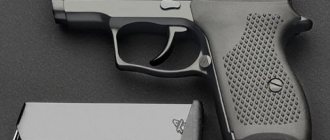Choosing a weapon
Professionals with extensive experience know that hunting requires a license to shoot wild boar. It is issued for the production of one animal. Next you need to decide on the type of weapon and caliber.
The rules prohibit the use of shot and buckshot in hunting ungulates, which includes wild boar. The use of these types of ammunition in wild boar hunting is ineffective. Small shot will only enrage the animal without even scratching it. Therefore, it is better to choose a bullet cartridge, but first decide on the type of weapon: smooth-bore or rifled.
Gladkostnoe
Most hunters in our country choose this type because of its availability. Any weapon is purchased subject to certain conditions, but for rifled weapons there are additional restrictions.
The most effective smoothbore gun for wild boar hunting is:
- 12 gauge inflicts heavy damage on the cleaver from a distance comfortable for the hunter. You won't have to miss the animal if you shoot in the slaughter areas.
- Double-barreled shotgun. It will help when you need to quickly fire a second shot to finish off the boar.
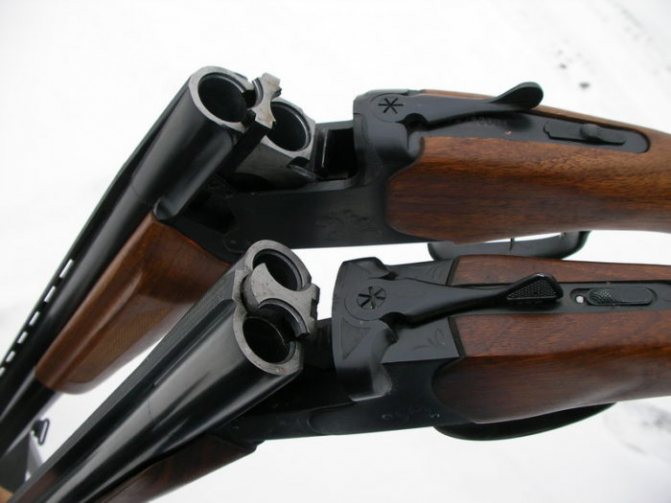
You should not choose a semi-automatic shotgun that does not guarantee that a second round will be chambered. The bolt may jam, creating a dangerous hunting situation.
To be specific, you can choose the following models: IZH MR-27M, TOZ-34, MR-153, IZH-27, IZH-26 and others. In any case, every hunter chooses a gun for himself.
Rifled
Rifled weapons are less popular. To obtain a permit, the following conditions must be met:
- hunting should be a professional activity.
- experience in smoothbore ownership - from 5 years and above.
There is a huge selection of rifled weapons on the market, but a carbine for hunting cleavers must be chosen meticulously.
The difference between this weapon and a smooth-bore weapon is that the barrel has rifling. They give the bullet rotation, increasing its flight range and stability.
The most effective indicators of rifled weapons for wild boar hunting:
- A caliber of at least 7.62 mm (for small and medium-sized animals); for adult animals it is better to use cartridges of at least 9 mm. You should not use cartridges with a caliber less than 7.62;
- As for the specific model of rifled weapon, the choice is made according to the individual parameters of the hunter. You can choose a rifle (has a stock for resting when shooting, a larger barrel size, weight and, as a rule, one charge), or a hunting carbine (lightweight body, shorter barrel, magazine for several shots).
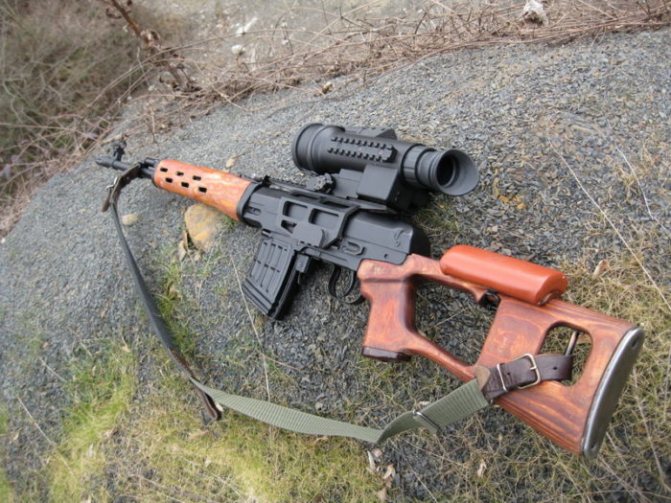
The range of models of rifled weapons with which you can effectively hunt wild boar is very wide, for example: “Tiger”, “Saiga”, “Elk”.
Rifled and smooth-bore weapons have their pros and cons. According to the experience of most hunters, it is better to choose a double-barreled smoothbore, and here's why:
- Most often, wild boar are hunted in a pen, in a forest with dense undergrowth. There is a high possibility of hitting a branch with a rifled weapon, which will lead to an unpredictable ricochet. Smooth-bore weapons have fewer such risks;
- In driven hunting, the shot distance is usually optimal for a smoothbore.
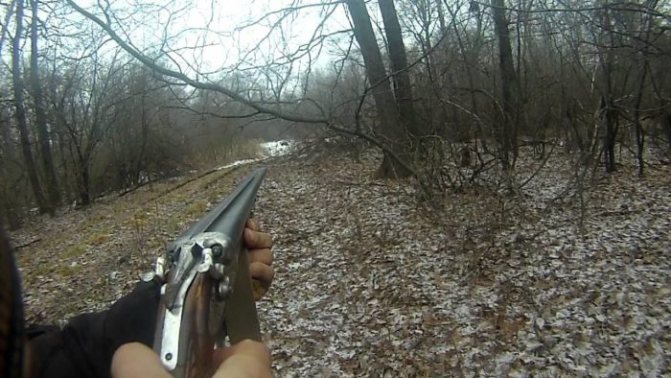
How to load cartridges on a boar

Let's study an example of loading cartridges with matched buckshot:
- For boar weapons of 12 gauge with a choke 17.4 in diameter and a cartridge case length of 70 mm, buckshot with a diameter of 5.8 mm is used. It fits in 4 rows of 7 pieces.
- For 16-gauge weapons with a choke diameter of 16 mm, buckshot of the same size is used. It is laid in four rows of 5 pieces.
- For a 20 gauge weapon with a 76 mm long case for a Magnum cartridge, take 20 pieces of buckshot with a diameter of 6 mm. It is laid in 5 rows.
It happens that a hunter preparing to hunt wild pigs does not have the required size of buckshot. Then an artificial agreement is created:
- The gap between the buckshot and the walls of the barrel is removed with a film of polyethylene. At the same time, the number of film layers is adjusted. For a good seal, other material is also used. You can use milk carton packaging and thick paper. Such cartridge additions are made when the buckshot diameter is smaller than the required size.
- If the buckshot has too large a diameter, then a cylinder of wood is installed in the center of each row. Its height is equal to the charge of buckshot. Then the sleeve is flared without the top gasket. Next, the wooden cylinder is removed. This ammunition increases the accuracy of fire by 25%.
Types of bullet cartridges and requirements for them
The weapon has been purchased, you need to select bullets. You need to start from the type of animal you will be tracking and the method of hunting.
To equip a bullet cartridge you will need:
- Capsule. Selected from the same year of manufacture or preferably from the same batch;
- Sleeve. Its length must correspond to the length of the chamber, without discrepancies in size;
- Powder. Taken from one batch. If there is not enough for all the cartridges, you need to use another batch of gunpowder;
- Wads and cardboard spacers;
- Bullets. It would be correct to weigh them additionally; the weight may vary, which is unacceptable.
There are a huge number of types of bullets in hunting stores, but preference is given to the following:
Brenneke bullet
Refers to the type of switch-turbine. To improve shooting accuracy, spiral ribs are applied to the body of the bullet, rotating it. The tail of the bullet is a felt wad. Connects to the head with a screw.
Has good accuracy and stabilization.

Mayer bullet
Refers to the type of turbine bullets with the most advanced design.
Monolithic lead body, head heavier than tail. In the center of the body is a cone-shaped void with blades inside. The air flow passing through the channel rotates the blades, which gives additional stability to the bullet. The most popular turbine bullet.
Main features: upon release from the barrel, rotation begins immediately. The firing range is 130-160 meters, a very high level of lethality.
Poleva bullet
Refers to a type of arrow bullets. Made in the form of an arrow, there is a tail at the end of the bullet, which serves to stabilize it in flight.
The production of this ammunition began in the USSR in the 80s. Consists of 2 parts: a small lead striking element and a plastic tail. The element is attached to the tail. A thick plastic container is placed on the tail section. A good effect in hunting, where the target is a large boar.

Features: improved accuracy, good ability to take down animals on the spot at a distance of up to 150 meters. Disadvantages: can deviate greatly in movement when slightly touching something.
Bullet "Gualandi"
Consists of 2 parts: a heavy lead head and a light plastic tail. The plastic tail stabilizes and prevents the breakthrough of powder gases in front of the bullet. The tip of the bullet is made in the shape of a cone.
Features: excellent stopping power, reduced risk of ricochet, does not lead to lead formation in the barrel.
Diabolo bullet
Its distinctive feature is its strong similarity to air gun bullets. Just increased the size.
Passing along the barrel of a weapon, it practically does not change its shape. Stable in flight. Feature: can be used in all types of barrel narrowings without causing deformation of the barrel.
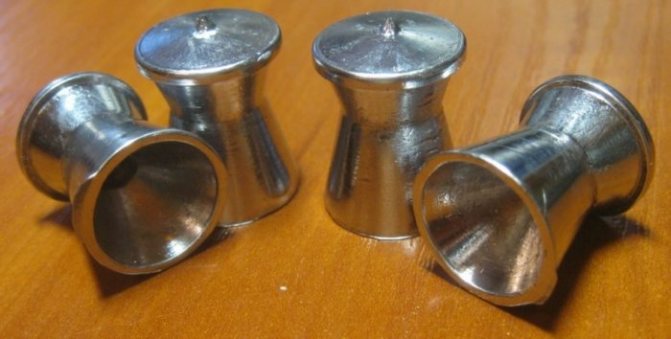
Provides combat stability and good stopping power and range. Selected by hunters for whom accurate shooting is important. Can be made at home.
Bullet "Blondeau"
Invented during the Second World War. The ammunition was supposed to disable unarmored German vehicles.
The head looks like a disk and the tail looks like a cylinder. On the tail, circles were machined into which lead rings were inserted. Can be made from brass, bronze and copper.
Feature: low risk of ricochet.
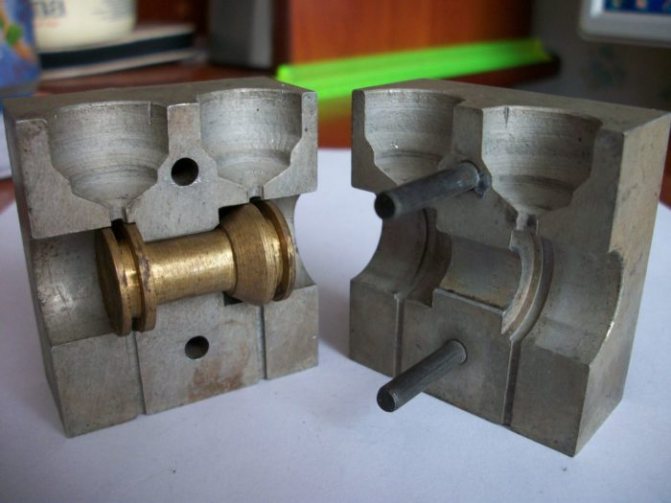
Other types of cartridges
If a rifled weapon is used to hunt wild boar or elk, the ammunition will be different. When choosing a carbine for hunting, you need to remember that if a foreign model of weapon is preferred, it is better not to choose a domestic cartridge.
If we talk about the caliber that is used for hunting cleavers, then the best in terms of lethality are considered:
- 9.3×62. The cartridge is mass-produced by different companies, combining it with a variety of bullets. Produces low recoil. For hunting in the forest, a weapon with a standard bolt is used; the cartridge is best suited;
- 338 Win. Powerful with a good flat trajectory, used when shooting at long distances, 300 meters or more. Very strong recoil;
- 9.3x74R. A good combination of lethality and low recoil. Universal, used in combined weapons;
- 8x68S and 9.3x64. Better lethality, firing range and low recoil. The disadvantage is that few companies produce cartridges of this caliber, and the choice of bullets for them is small. Used for hunting large elk and wild boars.
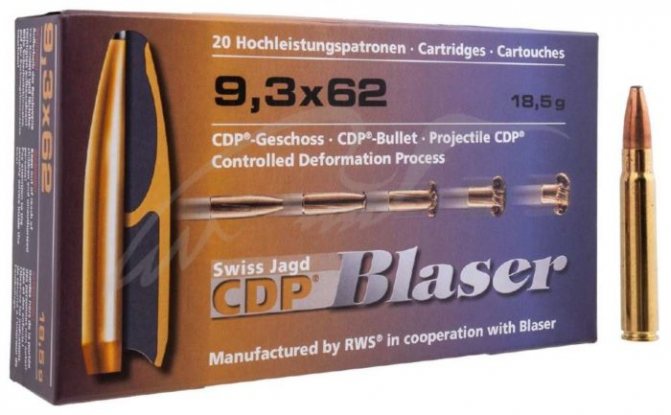
Tell me, what is better for hunting wild boar in the forest: bullets or 8.5 buckshot?
| 0 — 07.05.2009 — 11:32 | ? | |
| 1 — 07.05.2009 — 11:47 | Bullet, skill to shoot, good position | |
| 2 — 07.05.2009 — 11:57 | vadim026, what a question out of season;)) Probably planning to fight swine fever and flu :) Bullet, it’s certainly more painful, but it’s more difficult to get it right. Buckshot 8.5 seems to be weaker, but there is more of it in the cartridge;) | |
| 3 — 07.05.2009 — 12:17 | I agree with PaciFic, if the boar is just a bullet, well, you can pull the buck with buckshot, but not further than 20 meters. But it’s better to learn to shoot cleanly with a bullet, and then you can confidently hit at 80 kills. | |
| 4 — 07.05.2009 — 12:32 | and buckshot, it seems to me, is prohibited on wild boar, at least in Ameritinskaya | |
| 5 — 07.05.2009 — 13:55 | 1+ photo! | |
| 6 — 07.05.2009 — 14:33 | It depends on the situation. I agree with PaciFic, but often in the floodplains or in the mountains when you are standing on the path and the view is only 30 meters away, then buckshot comes in handy. | |
| 7 — 07.05.2009 — 16:58 | Familiar with 80 meters of wild boar to fell with 8.5 buckshot | |
| 8 — 07.05.2009 — 23:25 | TVV - I agree completely. If there’s a bullet in the barrel, and there’s a couple of three deer in front, then the bullet doesn’t roll towards the deer, but damn it’s like a pendulum, but you can meet it with buckshot. vadim026-7- Then the boar had a heart attack, the buckshot didn’t even reach. :-)))) | |
| 9 — 07.05.2009 — 23:45 | The first bullet was a more or less aimed shot, the rest were buckshot. 3: 20 meters?????? made me laugh :)))))))))) | |
| 10 — 08.05.2009 — 9:00 | 80 meters is good, of course, but for this there is no clear field. And in an open field, a carbine will be just fine. In the forest where I hunt, I have not yet encountered more than 30-40 meters of relatively clear space for a shot. Therefore, the question of which is better was simply solved: I bought a P/A and load it P-K-P-K-P, depending on the place and the expected meeting of the “probable enemy”, I change the sequence or load four cartridges, and add the fifth when I see it ( I hear) target. | |
| 11 — 08.05.2009 — 14:22 | kulin, 20 meters is of course funny, but in my opinion it’s even funnier to listen to the stories “A friend from 80 meters felled a wild boar with 8.5 buckshot.” And I’ve already heard hundreds of such stories. I myself have beaten a lot of BOAR with buckshot and how many meters? TVV, I meant that at 80 meters, if you hit the spot, you won’t go far. There’s no mention of visibility, although there are moments. You’re on one side of the beam, and the group is walking along the other slope of the beam, you can clearly see it in the snow, like at a shooting range. You can fire two aimed shots. | |
| 12 — 10.05.2009 — 18:36 | I will say right away that I am not an “expert” in either hunting ungulates or shooting. But I still have some experience in shooting ungulates, as well as some modest trophies. Therefore, allow me to speak on this issue. The question of shooting (not shot or bullet is important), I think it is relevant in any season or before it. I mean that it is in the off-season that you need to shoot and the more the better, and special attention should be paid to bullet shooting, because shooting with a bullet is a separate song and is strikingly different from shotgun shooting. Shooting a large animal in the forest. So, bullet or buckshot? I don’t think there can be a definite answer. I shoot both bullets and buckshot. Everyone has their own preferences, shooting training, and most importantly, a lot depends on the terrain .When shooting on oats, I only shoot with a bullet. But we are talking about shooting in the forest, although the forest is getting smaller every year. To say that the forests in our central zone are cluttered is to say nothing! The plots are overgrown like a jungle. The forest felled by the wind, has turned over the years into such rubble that it’s scary to walk, let alone rush to intercept the animal. It’s in such places that we keep the wild boar. Now directly about shooting the animal (in our conversation, boar) in the forest, a modest example of our small company from 4 people. I generally agree with PaciFic, TVV, Leshy. But for us the main thing is the terrain, in our case the forest. And the visibility in our forests is 25m, edge is 30m. I mean, seeing the animal is more or less open for a shot. Despite the fact that I’m a hound (I keep Russian hounds), we don’t use hounds on ungulate hunts. For this hunt we have two jags. In strong places, I think the bullet can fake (like tied buckshot), and a shot with buckshot will be more reliable (I mean it’s easier to hit )after all, distances up to 25m. And at such a distance, 8.5mm buckshot is a fairly reliable projectile. But in our case, only once, after being shot with buckshot, the animal remained in place. It was not a large animal, no more than 60 kg. 6 buckshots hit 8, 5mm, the distance is no further than 25m. In other cases, the animals walked from 50m to 1.5 km. And the longer the shooting distance, the further the animal goes. When there is snow, you can trail, but along the black trail, only the presence of dogs will allow you to get the wounded animal. Regarding the first shot with buckshot (on short) - this will allow, if you don’t put the animal down, then stop and correct the matter with a bullet. Regarding the fact that the bullet can fake. I mean that in a strong place the bullet almost always goes to the side. Despite this that Comrade Rubeykin and other shooters stated that the Rubeykin Bullet does not deflect when shooting through bushes and twigs, our experiments refute this. In our company (at different times), we used the following bullets: Diabolo (Gorbants), Rubeykin, Polev- 1 (notched), Poleva-3. Recently we only used Poleva-3. Now we switched to Poleva-6, shot it, but haven’t tried it on animals yet. A couple of years ago, we conducted a series of shootings with all the above-mentioned bullets. In small bushes , in the twig and aspen trees, targets were set up. They shot with the listed bullets from a distance of 35 m. So, the results are such that all the bullets left the trajectory, and most of them began to tumble (this is evidenced by the nature of the holes of some bullets that caught a 1m x 1m sheet, they are covered). They shot from guns MTs-21-12, MTs-6, TOZ-34, IZH-54. All guns were shot (at different times) with these bullets. They shot while sitting from a rest. The results indicate that it is not worth shoot a bullet even through small bushes. If anyone doubts it, try shooting. Perhaps your results will be different (although I doubt it). That’s why I’m talking about the reliability (in terms of hitting a thicket) of the first shot with short-range buckshot. And my conclusion is this. In relatively clean areas, I give preference to the bullet. Since with good shooting, the bullet makes it possible to take the animal at extreme distances. But if the hunt takes place in the forest, and goats are also possible, then have one barrel loaded with buckshot (in a double-barreled shotgun) will always be justified. And the effectiveness of shooting large 8.5mm buckshot of a medium boar, for me the 25m edge is 30m. Sincerely. We won’t talk about shooting wild boar with buckshot at 80m. Although I have the magazine “Hunting”, it talks about shooting wolves from a helicopter (in Evenkia, in my opinion). So, one of the game managers, literally...” some of the cartridges with buckshot I load it with black powder, it burns slowly, and although the sharpness of the battle decreases, the buckshot carries particles of burning gunpowder, WHICH CONTRIBUTES TO THE DEVELOPMENT OF A STATE OF SHOCK in the animal.” This is what happens.. And I don’t want to laugh, I want to cry!   | |
| 13 — 10.05.2009 — 20:06 | Reed fishermen: “The bullet is better in the floodplains. Go to… with your buckshot!))) | |
| 14 — 10.05.2009 — 20:07 | Damn snipers... | |
| 15 — 13.05.2009 — 23:41 | Maybe he forgot to say that they mix smoke and red pepper? :-))) | |
| 16 — 13.05.2009 — 23:45 | Yes, this also happens, the story of one hunter: “Over the past 23 years of active hunting not only for waterfowl, but also for ungulates in many regions and areas of our vast Motherland, I have seen and heard enough of all sorts of “troubles” and miracles from experienced and unprecedented hunters. It turns out that not every hunting bullet can be used on all hunts, although their production is not particularly difficult. The ban on use is mainly determined by safety regulations - the bullet should not ricochet off tree trunks, such as a ball made of solid lead or an analogue of this bullet. But it turns out that there is also a ban on ethical standards that determine the inadmissibility of cruelty to animals, subjecting them to inhuman suffering and torment in the process of commercial and, especially, sport hunting. One of these bullets has the hypocritical and sanctimonious name “Bullfight”. The essence of this poaching bullet is very simple: a small lead ball with a diameter of about 16mm with a hole in the middle through which a silk purple15 ribbon about 30mm wide and about 2mm long is passed. The tape is rolled up from the “tail” into a tight roll, placed in a cartridge case filled with gunpowder on a powder wad or, even better, a seal, and a ball is placed on top of a roll of purple tape in the middle and the sleeve is closed, preferably with a “star”, so that no one except The owner did not know about the presence of this “Bullfight” in his bandoleer. Moreover, the cartridge is equipped with a small amount of gunpowder “Sunar SV” (low-noise and flameless shot). Such a projectile does not need much speed - there is a possibility of the purple ribbon being torn off. The poacher prefers to shoot such a bullet not at the slaughter areas, but most likely at the loin parts of the elk. After such a bullet hits the buttocks, the animal will definitely see that it “stung” him so much, and when he sees something purple stuck in the side or somewhere else, he will literally go berserk and try to gore this rubbish. Have you ever seen a dog playing chase with its tail? Similar case! Only in all seriousness and to the point of losing consciousness. After the animal “without hind legs” falls and is unable to rise, the poacher cuts the poor fellow’s throat, releasing blood, and this is where the mockery ends. Many people ask: why is all this being done? If anyone is familiar with Chinese or Korean cuisine, then they know that the most delicious dog meat is obtained when a tied poor dog is lightly whipped with a twig for half a day, or even more, before slaughter, until it goes frantic. Thus, unwanted fractions are expelled from the animal’s body along with sweat, which negatively affect the taste of the game. Perhaps the history of bullfighting implied the removal of all sorts of “tastes” from the bull’s blood during the fight. But that's a separate conversation. We hope that such “advertising” of a poacher’s bullet “Corrida” will not affect innocent copyrights and we hope that the law-abiding nature of conscientious hunters in Russia will not allow the spread of the use of this type of ammunition in commercial or sport hunting for moose.” | |
| 17 — 14.05.2009 — 8:46 | Of course the bullet is pockmarked, what a question!!! And preferably 7.62 from a 51mm cartridge!!! | |
| 18 — 14.05.2009 — 10:34 | the elk gores himself :))) damn what the perverts don’t come up with :)))) | |
| 19 — 14.05.2009 — 15:27 | Yes, they raised an endless topic. It’s good to have a double-barreled gun, you can choose which barrel to shoot with, a bullet or buckshot. And when, single-barreled, MTs 21-12, right here, you’re already scratching your head. In our mountains, in the forest, most still prefer buckshot, even though it is prohibited. Especially owners of MP, 76 Magnum cartridge, 15 buckshot 8.5, at 20-40 meters, if hit, the beast has practically no chance. Regarding 80 meters, and buckshot, I can believe it, because... I myself personally knocked out a 2-year-old pig (not a mother) from a herd, and a 4-year-old boar, which was moving closely behind the herd. I shot at 72 steps, with a 391 Beret, a 76 Magnum cartridge, 15 buckshot 8.5 "Taiga", the pig lay down immediately, and the boar walked 50-70 meters (there were vouchers and licenses). To be honest, I like shooting with a bullet more, and if the terrain allows it, then I put the bullet first. | |
| 20 — 14.05.2009 — 17:28 | Lieutenant RZHEVSKY - In “Hunting and hunting.house-tvo” there was a page “The Blue Arctic Fox...” And here, for such stories you need a section - “The amazing is nearby”! Kuzmich - My friend, with MC 21-12, when hunting wild boar in the forest, always puts buckshot first, and just right for goats. And as for shooting at 80m, even with buckshot, well, I don’t know... In your case, 72 steps is about 50m. Serious researchers - shooters (not me), 50m for a smooth barrel, is recognized as the maximum distance for reliably hitting a bird (with shot ) and to the average beast (with buckshot) with an excellent cartridge. Which, in principle, is what your case proves. But do you agree that this is a case? The run of the second beast speaks for this. I wonder how many buckshots and where they hit? Regarding the notorious shooting at 80m. For the sake of practical interest, shoot at targets at this distance. Yes, and put up a shield of dry pine boards. I’m sure the results will be very far from expected. And if something hits, then check the sharpness. Sincerely!   | |
| 21 — 14.05.2009 — 17:56 | I myself am tall, and my step is 75 cm, so it turns out to be 50 meters, well, it doesn’t matter, these are little things. I don’t agree that this is an accident; in my arsenal there are more long-range successful shots at both cassula and chamois than unsuccessful ones. And there are also quite a few cases when I simply lowered the gun, due to the fact that there was buckshot first, because experience suggested that the distance for buckshot was not realistic, and I didn’t want to frighten the animal by jerking the bolt. Regarding 72 steps, a pig hit: head-neck, boar: shoulder blade (did not hit the heart), 8 buckshot in the body. It is impossible not to note that there are a lot of cases when, when a boar was hit by a bullet (not in the heart, not in the ridge), including a rifled one, one had to walk after the wounded animal for 1 km or more, especially from a mountain, or a spit. | |
| 22 — 14.05.2009 — 20:14 | Very often, when hunting wild boar, after an unsuccessful (or successful) shot, the team conducts a “debriefing”... And of course they ask the shooter the question: “How many meters did you shoot?” And we hear the answers: “..from seventy, forty, eighty meters,” etc. And in general, after visually assessing the distance (indicated by the shooter), everyone agrees or disagrees, but it is obvious that they never measure it. So am I. But last year I went to the quarry to check new bullets for myself. They put up a shield, measured 50 meters with a ROULette, and forward... But that’s not what this is about.. I just estimated the VISUALLY ACTUAL distance at 50 meters. And I realized that in the forest we often lie. FOR various reasons, sometimes in justification, and sometimes vice versa. In general, I think that Nik 179 is absolutely right. Talk about killing wild boars with buckshot at 80 m is either an accident or not serious. And then - what kind of accuracy should a gun have??? And if we also take into account our forested area, where there is not always a view even at 40 m, then... However, anything can happen, probably... | |
| 23 — 14.05.2009 — 22:15 | sheko Practically answered for me! I'll have to knock on the keyboard less. Kuzmich - Shooting while hunting, the situation, emotions... This is where the talk comes from about shooting geese, hares, etc. at 70m, and now wild boars with buckshot at 80m. And what’s typical is that people don’t consider this an accident! So I’ll repeat it. Carefully measure the distance (not in steps), place the target with pine (dry) boards, and shoot without unnecessary emotions. And there will be a clear, real picture of the shot. And if you consider your result to be the rule and not the exception, then why do you need bullets at all? Shoot with buckshot.   | |
| 24 — 14.05.2009 — 23:39 | Yes, distance is a controversial issue. I don’t respect hyperbolic statements, that’s why I love real things. Including real girls. I got distracted... Often the confectioners overestimated my performance, I keep insisting on reducing the distance figure. Once they started talking about this, I forced them to name the distance to the conditional object. One named the number 95m. the other is 105m, I called it 56m. I brought a tape measure, measured it, and it ended up being 55m. This is because, I think, I sometimes shoot at distances from smooth, as well as from rifled 35m-50m-100m, and that explains everything. You’re right, when hunting, under the influence of emotions, the roulette wheel can sometimes be tripled. Maybe from fear of a torpedo moving head-on. :-)))) Hi all. | |
| 25 — 15.05.2009 — 7:38 | So much has been written that it’s even thorough, it seems... I’ll also speak out :) I’m 27 years old, now I go hunting for animals 1-4 times a year, when I was in school I climbed the mountains every weekend with a team, now it’s only very high in I go out to the mountains once a year, the rest of the time I hunt in the forest. In my entire life I have never shot buckshot and I will forbid my grandchildren from doing so... In the mountains, where the distance is over 80m. and where the opportunity to make a second aimed shot is very difficult, I take a carbine (automatic) For the forest, where visibility sometimes does not exceed 20 meters due to all sorts of bullshit, only a double-barreled shotgun... I consider an automatic rifle in this matter a dangerous undertaking, the first and most dangerous moment is a misfire, you can simply If you don’t have time, the animal will have time... The second point is that you won’t be able to shoot a hare, a fox, or a jackal with a bullet (provided that we’re not just shooting a wild boar). Regarding shooting through the hmyznyak. No matter what you shoot, be it from a carbine or from a cannon, there will always be ricochets with hunting cartridges, and the lighter the projectile, the more susceptible it is to deflection. An incident from life: Before every hunt, we warn you that we leave buckshot in the car... A neighbor is standing at a license plate about 100 meters away, we are standing along the road, shooting in front of us, ten meters in front of me, branches from buckshot break. What I mean is that buckshot supposedly has more options to hit an animal in the middle of nowhere... YES, to hell with this beast, don’t you feel sorry for your own lives??????? The second aspect, are you going to a training camp or is shooting at a wild boar at 20-50 meters causing you difficulties?????? Somehow I was standing at the end, the shooting started from the first number, well, I kept thinking, no one would get to me, in the end, with 50 shots in the shoot, two unfortunate pigs finally came to me... The question mostly comes down to discipline and nerves. And of course there are various moments behind you, for example, I once shot with a gun at 100 meters at pigs walking calmly, as a result I was wounded and weaving through the forest in search of it (I found it), without snow... Regarding determining the distance, if you yourself walked with your feet and know where is your shooting zone, then there shouldn’t be any special questions, but if the place is not familiar... In the field, we’re looking through binoculars, It looks like a mother with a young yearling, 300-400 meters away, a mother about 600 meters away, The one that came closer is that the yearling is 150-170 kilograms, but what Then what kind of mother was it still remains a question :) Now I have a rangefinder for the mountains. Oh, I signed something :) If something goes wrong, please forgive me. But you need to look for the reasons in yourself, and not in the means (buckshot). | |
| 26 — 15.05.2009 — 13:21 | BENDES that's right!    | |
| 27 — 15.05.2009 — 13:31 | A great shot at a wild boar. The hunter had only one gap, about 4 meters wide, where he could intercept a rushing boar with a bullet. https://youtube.com/watch?v=lRJMscZ4uX8&feature=related | |
| 28 — 15.05.2009 — 13:39 | alexyus Open road, is this a failure? And of course it’s a beautiful shot.   | |
| 29 — 15.05.2009 — 14:04 | No, of course not, the open road is overgrown   | |
| 30 — 15.05.2009 — 14:18 | It is now clear   | |
| 31 — 15.05.2009 — 16:41 | I won’t be clever anymore, I’ve been hunting officially since 1986, I never lie or exaggerate, I told you how it was. | |

Hot Key Forum | Channel on YouTube - Hot Key Video - if you want me to film a certain part of the city on video, write in the application channel. | About Goryachiy Klyuch - social infrastructure. Banks, Police, Administration, Hospital, Clinic, Police... | Populated areas of Goryacheklyuchevsky district | Hot Key for children. Schools, kindergartens, sports sections, clubs, leisure | Sanatoriums, holiday homes, hotels | Treatment - healing factors of the hot spring, herbs, water, natural products. | Around the city - city tours, photographs, video reports from different parts of the city. | Real estate - how to move to Goryachy Klyuch. Features of the city, climate, areas, developers, realtors | Transport - how to get to Goryachiy Klyuch, railway transport, bus transport. | Forum archive | Construction of houses |
Buckshot to match the muzzle of the gun
They go hunting for wild boars with a shotgun, the equipment is 12-gauge buckshot. If buckshot is used in hunting, it must be consistent with the muzzle narrowing of the gun. A plastic container is filled with buckshot, laid in layers, and the voids are filled with sawdust.
If the hunter does not have suitable buckshot, but has smaller buckshot, an artificial match is made. The void between the barrel and the buckshot is eliminated by stuffing thick paper there.
If the buckshot is larger in diameter than needed, a wooden cylinder is placed instead of the main one. Then the sleeve is rolled and the cylinder is removed.
How to stack buckshot for cartridges
The layout of buckshot shells is one above the other. For strict fixation I use wooden sticks.
It is most convenient to load buckshot into a polyethylene container. Layers of buckshot are sprinkled with sawdust or polyethylene chips.

Weapons and ammunition

Hunting for wild pigs is usually carried out by many Russian hunters using smoothbore weapons. Shotguns from 12 to 20 gauge are used to shoot wild boar. Considering the boar's resistance to wounds, it is better to use weapons with Magnum cartridges. Such ammunition is loaded with buckshot with a diameter of 6 mm. This buckshot is used for muzzle narrowing of the barrel. The exact size is affected by the caliber of the weapon.
Winter cartridges
In winter, hunters use a slightly different type of cartridge:
- It is better to take paper sleeves with a metal head;
- choose Zhevelo capsules.
Such cartridges can withstand a powerful charge. Applicable for smooth-bore and self-loading weapons. They will not be reliable for magazine-launched weapons; the cartridge case may get caught, causing a misfire.
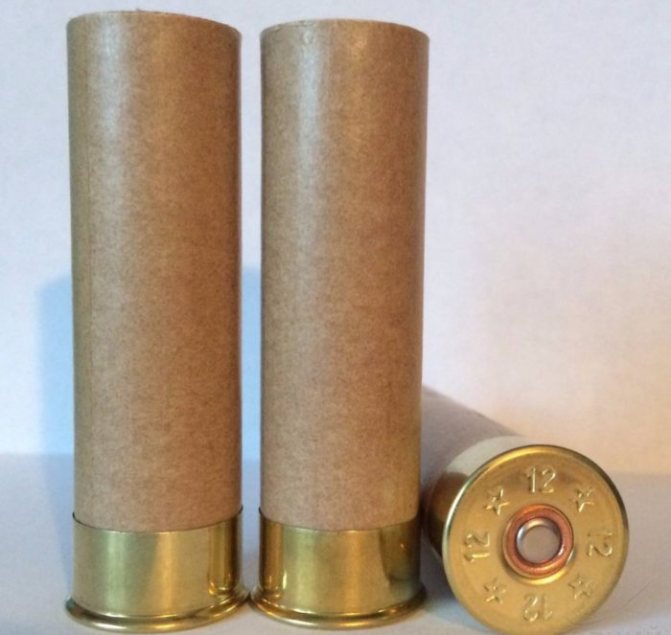
How to stack buckshot
When stowing ammunition yourself, buckshot is placed in rows. One row is located above the other. To secure the buckshot in this position, matches are usually inserted into their spaces. The most convenient option for loading buckshot cartridges is a polyethylene container. The buckshot in such a box is located in layers. The gaps are filled with polyethylene crumbs. In winter, you need to put a salted felt wad under the container. It will not lose elasticity in the cold. As a result, the powder gases will be sealed, increasing the accuracy and sharpness of the shot.
Types of cartridges and shot numbers for 12 gauge
Each hunter himself selects for himself the numbers of fractions convenient for hunting a particular animal or bird. Some people shoot at a goose with shot number 1, since it hits the head, while others use shot number 00, since it is more difficult to penetrate the dense feathers on the chest with one.
| Fraction number | Diameter, mm | On whom |
| 12 (small) | 1,25 | Quail, snipe, snipe and other small birds |
| 11 (small) | 1,50 | |
| 10 (small) | 1,75 | |
| 9 (small) | 2 | |
| 8 (small) | 2,25 | |
| 7 (small) | 2,50 | Ducks, pheasants and other larger birds, teals |
| 6 (small) | 2,75 | |
| 5 (small) | 3 | |
| 4 (average) | 3,25 | Can be used on goose, hare, black grouse |
| 3 (average) | 3,50 | |
| 2 (average) | 3,75 | |
| 1(medium) | 4 | Hare, goose, fox, wood grouse. |
| 0 (large) | 4,25 | |
| 00 (large) | 4,50 | Larger animals such as roe deer, lynx, etc. Can be used on hare, goose |
| 000 (large) | 4,75 | |
| 0000 (large) | 5 |
The table shows the numbers of fractions, their diameter and who they are used for. The fraction pitch is 0.25 mm. As can already be seen, the higher the number of the fraction, the finer it is.
